It’s undeniable that modern life is more sedentary than ever.[1] Between work-from-home set-ups, time sitting on long commutes, and doomscrolling on the couch, our bodies spend a lot of time in the same positions. That’s why your muscles can seriously use the chance to stretch out and reset.
Luckily, you don’t have to be a yoga guru to get started with home stretching. Let’s take a look at why a daily stretching routine matters, how to start building your own daily home workout stretching routine, and how the expert stretch providers at your local Massage Envy franchised location can help.
Why you should do at-home stretches regularly
Even if your workout routine looks more like walking the dog or chasing after your kids, your muscles are still logging long hours. Tight hips, stiff shoulders, and achy lower backs have become part of the modern routine—but they don’t have to be.
Incorporating just a few minutes of home stretching into your day can make a huge difference in how you feel and move. Here’s what science says regular stretching exercises can do for you:
Help improve flexibility and range of motion
Regular stretching can improve your flexibility, helping you increase your range of motion over time.[2] This can lead to improved functional mobility, aka your ability to move around freely in your everyday life.
Help ease muscle tension and stiffness
Stretching may help relax your muscles, which can ease tightness in your neck, shoulders, hips—anywhere you hold tension (so, everywhere?). Studies have shown that a daily stretching routine can help ease muscle stiffness over time.[3]
Help support better posture and body alignment
Stretching the muscles that get short and tight from sitting (like your hip flexors and chest) helps realign your body and reduce that hunched-over feeling.[4] [5] It also may support your lumbar spine, the part of your lower back that bears much of your body’s weight and is especially prone to tension from poor posture.
Enhance overall well-being
Stretching feels good and does good. It can help ease everyday stress, and has been found to promote a more positive mood.[6] [7] Clearly, our bodies really crave movement. And even gentle methods, like stretching exercises, can help make a big difference and represent easy ways to show your body some TLC.
Quick tips for safe home stretching
Before you jump into your daily home workout stretching routine, keep these simple tips in mind to make the most of your time and keep your muscles safe. If you have any questions or concerns, consult with your health care expert or doctor before engaging in any home stretching regimen.
- Warm up first. Start with a few minutes of light movement, such as walking, arm circles, or dancing around your kitchen, to get your blood flowing.[8] Stretching cold muscles isn’t ideal.
- Hold each stretch for at least 30 seconds. The longer you hold a stretch, the greater the gains you could see in range of motion over time. If you’re feeling confident (or particularly tight), you can even hold for 45–60 seconds. Just don’t push yourself beyond your limits as you start out—even a 15-second stretch can have a big impact.[9]
- Don’t bounce—stay still. Gentle and steady wins the race. Bouncing into a stretch (sometimes referred to as ‘ballistic stretching’) can actually increase your risk of pulling a muscle.[10]
- Stay in your comfort zone. You should feel a gentle tug, not pain. Never force your body into a position it’s not ready for. If you don’t feel a stretch in that area, that’s another reason not to force the stretch, and you can move on to another area.
- Breathe deeply. Inhale through your nose, exhale through your mouth, and try to relax into the stretch. Focus your breath on the area you're targeting.[11]
- Stretch both sides equally. Give your right and left side the same amount of love to keep your body balanced and symmetrical.
Consistency and care are key. Home stretching is a great opportunity to slow down and connect with your body, learning where your tightness lives and what motion helps ease it.
The 12 best at-home stretches
No equipment. No fuss. Just your body, a few free minutes, and a daily home workout stretching routine built to help ease tension, improve flexibility, and give your hardworking muscles the attention they deserve.
Here are some great stretching exercises for beginners to do at home:
Remember that stretching is not meant to diagnose, prevent, or treat any medical condition. Please discontinue at once if you begin to experience any form of discomfort or severe pain in any area of your body, and talk to your doctor or medical provider if you have any questions and before you start any stretching regimen. You should understand that when participating in any stretching or stretch routine, there is the possibility of physical injury. By participating in home care stretch routine you agree that you do so at your own risk, and are voluntarily participating in these activities.
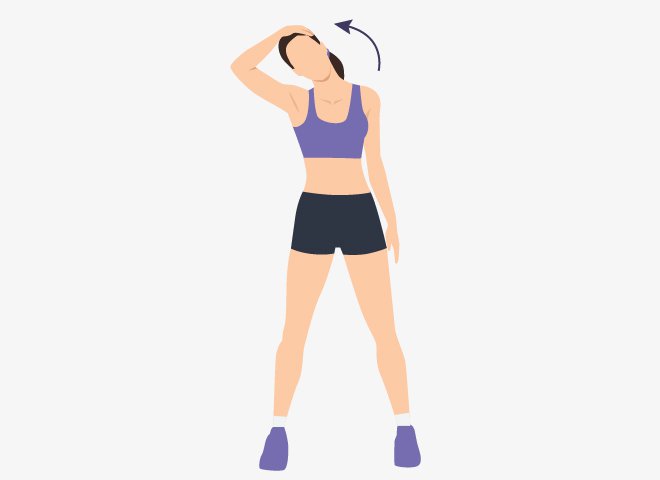
1. Side of Neck Stretch
What it targets: Upper traps and scalene muscles (aka the ones that tighten from ‘tech neck’)
How to do it: Sit or stand tall. Gently tilt your head to one side, bringing your ear toward your shoulder. Keep your shoulders relaxed and down. For a deeper stretch, lightly place your hand on the side of your head (no pulling!) and just hold.
Why it helps: Helps to ease neck tension related to looking down at devices or hunching over desks.
Pro tip: Don’t shrug your shoulders. Keep them soft and away from your ears.
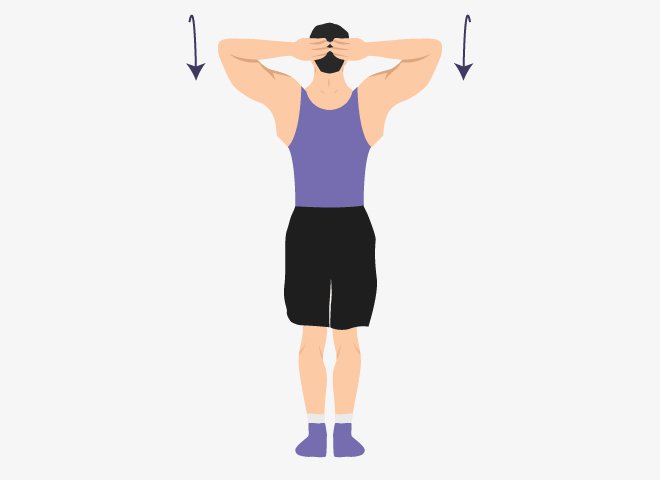
2. Back of Neck Stretch
What it targets: Back of the neck and upper spine
How to do it: Interlace your fingers and place your hands on the back of your head. Gently tuck your chin to your chest as you guide your head forward. Stop when you feel a stretch through the back of your neck.
Why it helps: Relieves everyday tension built up from poor posture or stress-clenching.
Pro tip: Focus on rounding your upper back slightly to deepen the release.
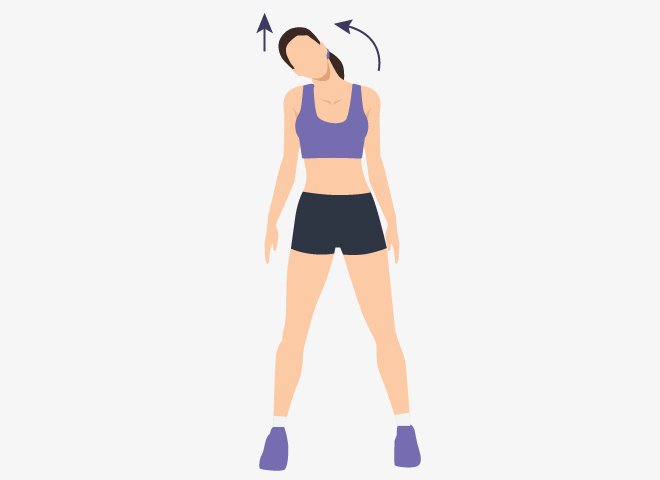
3. Front of Neck Stretch
What it targets: Sternocleidomastoid (the long neck muscles that stretch from your sternum to the back/side of your head, responsible for head-nodding and -shaking) and anterior neck muscles
How to do it: Sit or stand tall. Tilt your head back slightly, then gently tilt your head to one side and look up toward the ceiling. You should feel a stretch along the front and side of your neck.
Why it helps: Balances out tight neck muscles and encourages a more upright posture.
Pro tip: This one’s subtle—don’t force it. A gentle stretch is still effective.
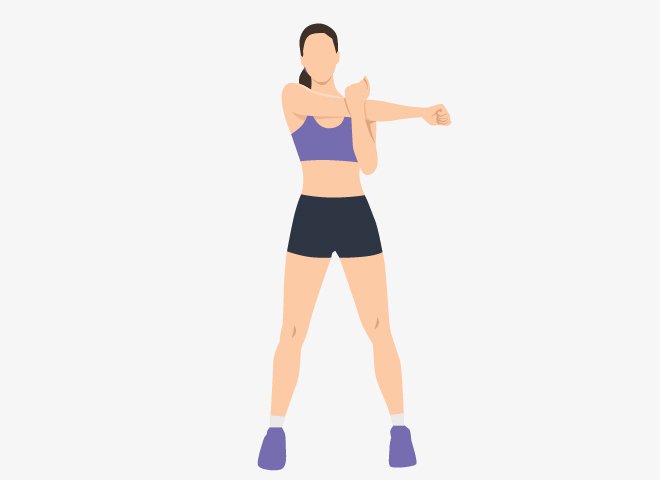
4. Shoulder / Rotator Cuff Stretch
What it targets: Rear deltoid and rotator cuff
How to do it: Bring one arm across your body at shoulder height. Use your opposite hand to gently press your upper arm closer to your chest.
Why it helps: Loosens shoulder joints and helps improve mobility. This is especially helpful if you spend a lot of time at a computer.
Pro tip: Keep your shoulder down (don’t let it creep up toward your ear!).

5. Side of Spine Stretch (Standing or Seated Side Bend)
What it targets: Lats, obliques, rib muscles
How to do it: Raise one arm overhead and gently lean to the opposite side, keeping your body in the same plane (don’t twist). You’ll feel a stretch along your side from hip to shoulder.
Why it helps: Improves flexibility through the ribs and spine—great for posture and breathing.
Pro tip: Keep your hips grounded (or evenly weighted) for maximum benefit.
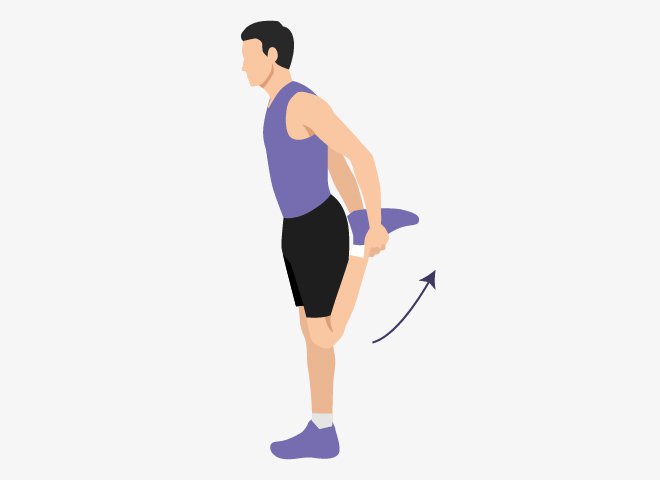
6. Thigh / Quadriceps Stretch
What it targets: Quads and hip flexors
How to do it: Stand tall and grab your right ankle behind you with your right hand. Keep your knees together and gently pull your foot toward your glutes.
Why it helps: Counteracts tightness from sitting or running.
Pro tip: Hold onto a chair or wall for balance so you can focus on the stretch, not wobbling.

7. Hamstring + Low Back Stretch
What it targets: Hamstrings, glutes, and lumbar spine
How to do it: Stand with your feet hip-width apart. Hinge forward at your hips and let your upper body hang toward the floor, keeping a soft bend in your knees. Let your arms dangle or reach toward your toes. Keep your spine long and avoid forcing the stretch.
Why it helps: Gently lengthens the entire back side of the body, from your calves to your lower back, helping to ease routine tension.
Pro tip: Place your hands on a block or your thighs for support if the floor feels too far away.
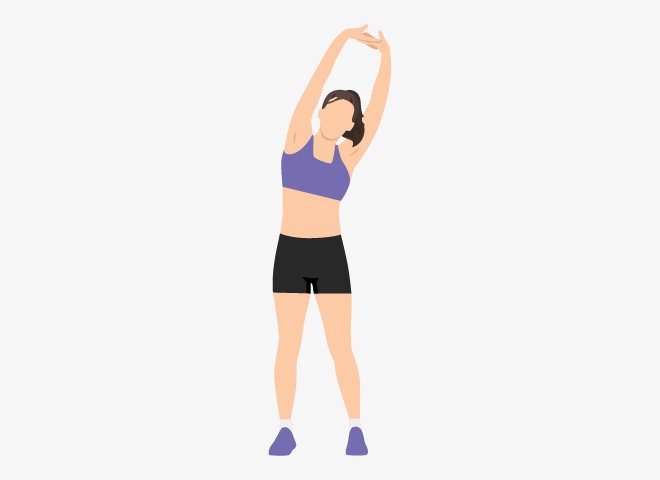
8. Full Body Reach + Stretch
What it targets: Entire body—especially spine, shoulders, and core
How to do it: Stand tall and reach both arms overhead. Interlace your fingers and flip your palms up. Stretch tall through your fingertips and inhale deeply.
Why it helps: Energizes the body, promotes posture awareness, and supports overall flexibility.
Pro tip: Add a gentle side bend to each side for an extra bonus stretch.
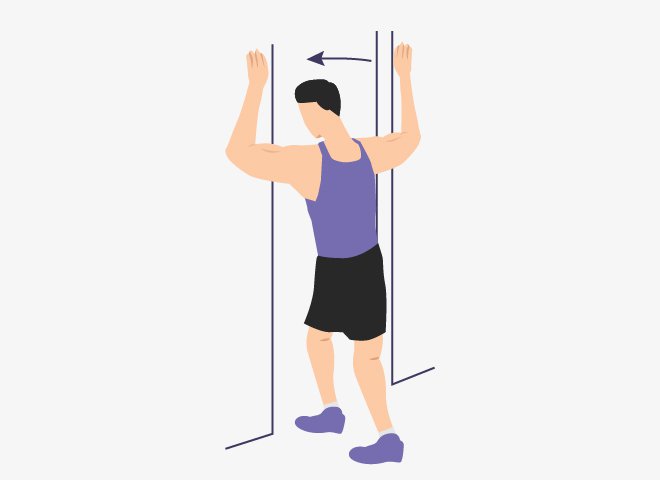
9. Chest Stretch (Doorway Stretch)
What it targets: Pectoral muscles (chest) and front shoulders
How to do it: Stand in a doorway and place your forearms on either side of the frame, elbows at shoulder height. Step one foot forward and gently press your chest through the doorway.
Why it helps: Opens up the front body after long periods of sitting or slouching.
Pro tip: Keep your chin level and core engaged so you’re not arching your low back.
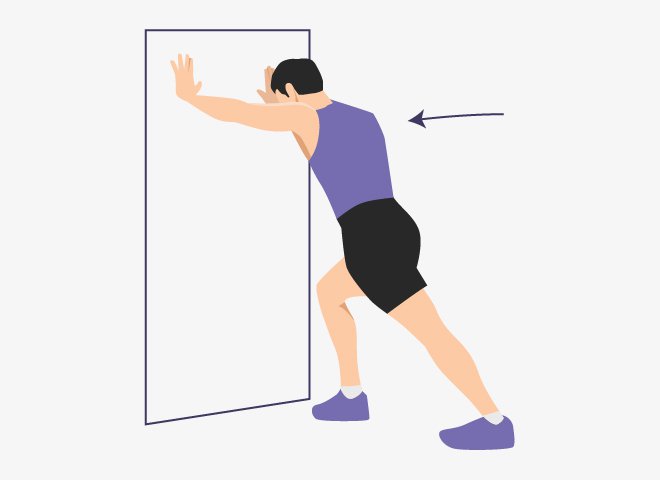
10. Middle Calf Stretch (Wall or Step Stretch)
What it targets: Gastrocnemius and soleus muscles (calf complex)
How to do it (wall): Stand facing a wall. Step one foot back and press the heel into the floor, keeping the back leg straight. Lean forward slightly.
How to do it (step): Stand on a step with your heels hanging off. Slowly lower your heels down to feel the stretch.
Why it helps: Improves general ankle mobility and reduces foot and leg fatigue.
Pro tip: Slightly bend your back knee for a deeper soleus stretch.
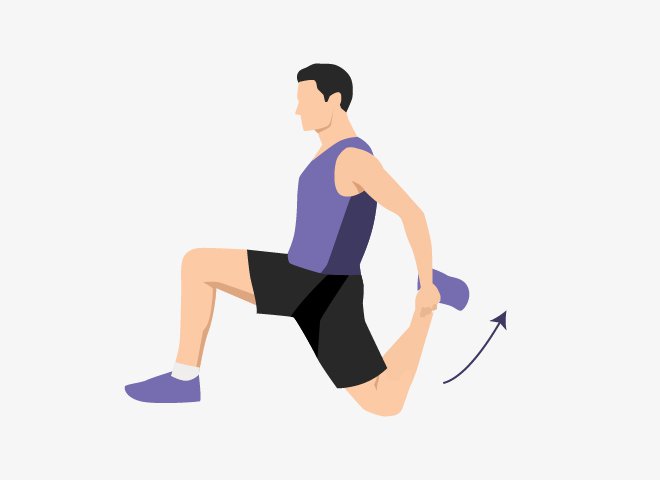
11. Hip Flexor / Psoas Stretch
What it targets: Hip flexors, psoas, and the front of the pelvis
How to do it: Step into a lunge position with your back knee resting on the floor. Press your hips forward until you feel a stretch in the front of your back leg.
Why it helps: Loosens tight hips, eases low back aches, and improves posture.
Pro tip: Engage your core and tuck your pelvis slightly to deepen the stretch. Stretch an arm across your head and lean to the side in a side bend to deepen the stretch further.
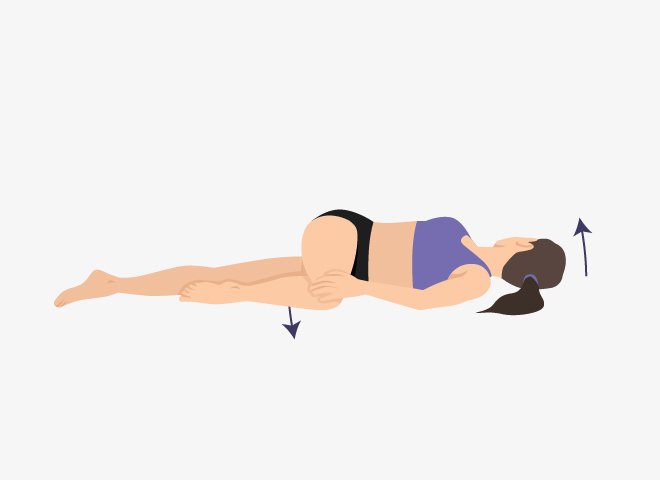
12. Lying Spinal Twist
What it targets: Spine, lower back, obliques
How to do it: Lie on your back with your knees bent. Drop one (or both!) knees to one side while keeping your shoulders flat on the floor. Turn your head in the opposite direction of your knees.
Why it helps: Eases everyday low back tension.
Pro tip: Keep both shoulders grounded to avoid over-twisting.
Go deeper with Total Body Stretch Therapy at Massage Envy
While at-home stretches are a fantastic way to maintain flexibility and relieve tension, sometimes your body craves a deeper, more targeted approach. That's where Total Body Stretch at Massage Envy comes in, a professional assisted stretch service designed to help you move better and feel better.
Why book a stretch session with a pro?
- Go deeper, safely. Trained Stretch Providers at Massage Envy franchised locations gently guide your body into deeper stretches while helping you stay relaxed and supported. Learn more about what to expect from stretch.
- Personalized to you. Whether you're stiff from sitting, tight from training, or need help loosening a specific muscle group, each session is customized to your goals.
- See and feel progress. Regular stretch sessions can help improve flexibility, mobility, and performance.
- Pair it with massage for full-body benefits. Massage helps ease everyday muscle tension. Stretching can help improve range of motion.They’re even better together. You can even try pairing your stretch session with Rapid Tension Relief, which uses percussion technology to quickly target tight spots for additional support.
If you’ve been stretching solo and still feel tight, or just want that extra level of care, book a stretch session at your local Massage Envy franchised location today.